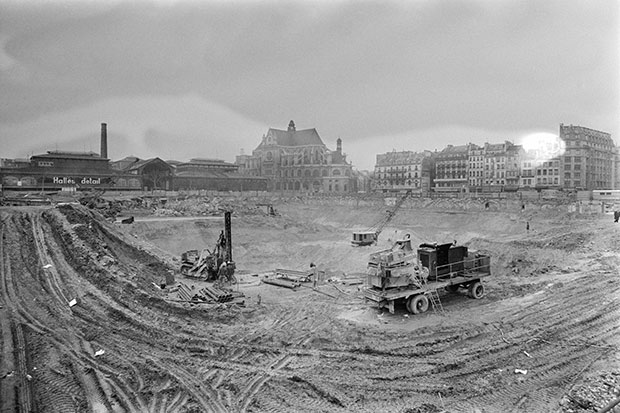Depending on your point de vue, Haussmann’s imperial scheme for Paris created townscape of thrilling regularity or boring uniformity. Whatever; against a backdrop of serene haute-bourgeois perfection, intrusions have always been controversial.
Eiffel’s tower of 1889 was attacked by the intellos of the day. Maupassant, Gounod and Dumas fils thought it a hideous construction of riveted tin. Le Corbusier’s unrealised 1925 Plan Voisin, replacing monuments with motorways, was designed as a shock to the system. And the 1973 Tour Montparnasse, central Paris’s only tall building, is, by general agreement, brainless. The Centre Pompidou of 1977 was a test for taste while the 1989 Bastille Opera is grossly ham-fisted, the last and worst of les grands projets.
And now we have in Les Halles, La Canopée, a vast, rippling, openwork structure comprising 7,000 tons of steel and 18,000 sheets of glass rising 15 or so metres above the 75,000 square metres of ground it covers. This Meccano géant is a dramatic new cloak thrown over the repurposed remains of an unloved shopping mall and a very busy subterranean rail hub five floors below. Cultural collateral includes a ‘centre hip hop’ of 1,400 square metres.
La Canopée’s profile and surface are inspired by the connected pattern made by the crowns of forest trees. Despite the implied sensitivity of this nod to ecology, La Canopée has returned Paris to one of its regular fits of architectural introspection. Although the city can claim an impressive collection of high modern heroes, the French are often inept at, and uneasy with, modern architecture. Just look at La Défense.
Les Halles, in the first arrondissement, was Zola’s Le Ventre de Paris (The Belly of Paris), the site of the city’s ancient and gutsy market. The culinary legacy of this remains only in places like Dehillerin, the world’s best kitchen-equipment shop. It was in Les Halles that between 1853 and 1870 Victor Baltard, Architect of the City of Paris, built 12 magnificent iron and glass pavilions, creating a new market on a site where food had been traded since the Middle Ages. They are overlooked by the completely mad church of Saint-Eustache, which combines, by no means entirely successfully, gothic and classical elements.
You need a bigger word than ‘eclectic’ to describe Saint-Eustache, but somehow it reflects the mood of an area that has accommodated the delicious and variegated demi-monde that markets always attract: butchers, porters, whores, thieves, all-night cafés with suicidal drinkers.
Then, in 1971, timed to coincide with the summer break so the absent citoyens might not notice, Baltard’s Les Halles was demolished by decree. As an act of doctrinaire official vandalism, it rivalled, possibly even surpassed, the demolition of the Euston Arch in 1961 or McKim, Mead & White’s Penn Station in 1963.
In 1970 I had been a student travelling through Paris and there was already unease about plans for the market. I picked up a sticker saying ‘Sauvez Paris 1er, Sauvez Les Halles!’ and on my return put it on the back window of my Ford Cortina which, by the standards of Manchester in the Seventies, was pretty cool.
But larger forces were at work. As if in a calculated insult to the spirit of Guy Debord’s handbook of dissent, La Société du Spectacle, of the year before, the authorities committed Les Halles to a specially dirigiste and stupid exercise in planning grandiosity. Baltard’s elegant and evocative engineering was replaced by the Forum des Halles. The food market was moved out of town to Rungis. Meanwhile, one of his original pavilions was retained and removed, a tad apologetically, to Nogent-sur-Marne, rather as Paxton’s Crystal Palace was relocated to Penge.
That word ‘Forum’ was a telling piece of period architectural doublethink: while suggesting dignified civility and continuing tradition, this Forum became not a meeting-place for fine minds, but a savagely unpleasant collection of trashy shops perfumed by the electrical and endocrine aromas arising from the vast station below. It did not take long before the Forum became a stained agora for loiterers, drug-dealers and other undesirables. In only one way did it excel: without rival, Les Halles was the nastiest part of Paris. Bad design turned the belly into un trou.
La Canopée was the result of an architectural competition won by Patrick Berger, best known for his intelligent restoration of the Viaduc les Arts along the avenue Daumesnil, where railway arches have been stylishly turned into art galleries.
La Canopée’s ‘formes curvilignes’ have, Berger says, been inspired by the forces of rain, wind and the mighty flux of commuters that swirl around Les Halles. Berger says you have to imagine that this is the ceremonial entrance to Paris, but moved to its centre.
Local response to La Canopée has, despite traditions of violent indignation about innovation, been muted: neither very enthusiastic nor very critical, although there have been complaints about leaks. Berger intended that his structure should be ‘translucide’ and by day the natural light is nicely diffused while at night the visual dynamic is reversed and the wavy canopy becomes luminous and substantial. Many visitors are, however, uneasy with the strange yellow cast of the steelwork, often likened to urine, possibly an unconscious olfactory reference to the atmosphere heretofore.
There’s a fine old quip about the French way of thinking: ‘It’s all very well to say it works in practice, but does it work in theory?’ As yet, it’s not quite clear whether La Canopée will heal the old wound of the Forum Les Halles. Theoretically, it does.






Comments